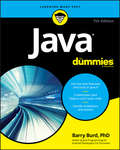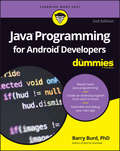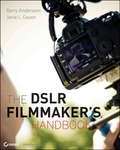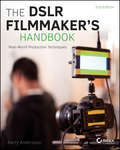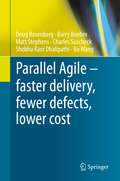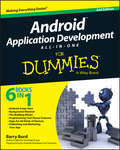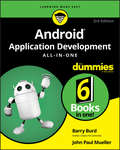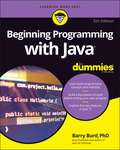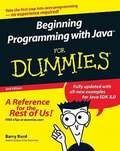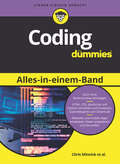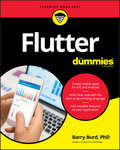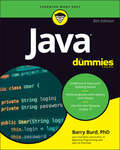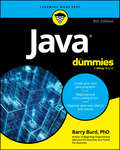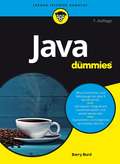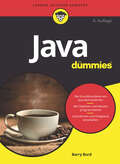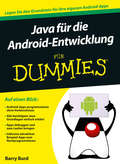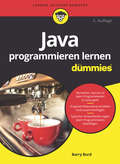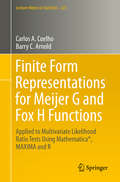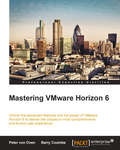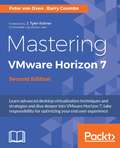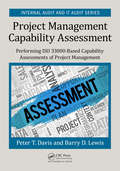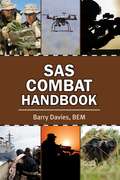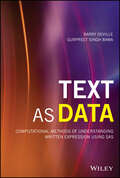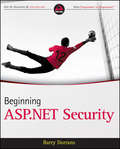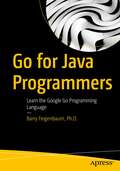- Table View
- List View
Java For Dummies
by Barry A. BurdA new edition of the bestselling guide to Java If you want to learn to speak the world’s most popular programming language like a native, Java For Dummies is your ideal companion. With a focus on reusing existing code, it quickly and easily shows you how to create basic Java objects, work with Java classes and methods, understand the value of variables, learn to control program flow with loops or decision-making statements, and so much more! Java is everywhere, runs on almost any computer, and is the engine that drives the coolest applications. Written for anyone who’s ever wanted to tackle programming with Java but never knew quite where to begin, this bestselling guide is your ticket to success! Featuring updates on everything you’ll encounter in Java 9—and brimming with tons of step-by-step instruction—it’s the perfect resource to get you up and running with Java in a jiffy! Discover the latest features and tools in Java 9 Learn to combine several smaller programs to create a bigger program Create basic Java objects and reuse code Confidently handle exceptions and events If you’re ready to jump into Java, this bestselling guide will help keep your head above water!
Java Programming for Android Developers For Dummies
by Barry A. BurdDevelop the next killer Android App using Java programming! Android is everywhere! It runs more than half the smartphones in the U.S.--and Java makes it go. If you want to cash in on its popularity by learning to build Android apps with Java, all the easy-to-follow guidance you need to get started is at your fingertips. Inside, you'll learn the basics of Java and grasp how it works with Android; then, you'll go on to create your first real, working application. How cool is that? The demand for Android apps isn't showing any signs of slowing, but if you're a mobile developer who wants to get in on the action, it's vital that you get the necessary Java background to be a success. With the help of Java Programming for Android Developers For Dummies, you'll quickly and painlessly discover the ins and outs of using Java to create groundbreaking Android apps--no prior knowledge or experience required! Get the know-how to create an Android program from the ground up Make sense of basic Java development concepts and techniques Develop the skills to handle programming challenges Find out how to debug your app Don't sit back and watch other developers release apps that bring in the bucks! Everything you need to create that next killer Android app is just a page away!
The DSLR Filmmaker's Handbook
by Barry Andersson Janie L. GeyenA how-to guide for getting professional-quality video from your DSLR Shooting HD Video with a video-enabled DSLR has many benefits and some tricky drawbacks that digital filmmakers and videographers can overcome to get professional results. The DSLR Filmmaker's Handbook helps filmmakers harness the HD video capabilities of their DSLRs to create professional-level video. Packed with professionally-tested techniques, this indispensible book serves as a training guide for the complex steps that must be taken before, during, and after filming. Teaches you the key tools and techniques for using your DSLR to shoot high-quality, professional-level video Distills dense information about filmmaking and filters it down to easily understood granules Shows you what to expect and what to avoid with your DSLR and how to maximize the visual look of your film Shares tools and techniques that have been used in real-world, independent movie-making environments The DSLR Filmmaker's Handbook shows you how to overcome any tricky drawbacks that you may face while shooting HD video with your DSLR.
The DSLR Filmmaker's Handbook
by Barry AnderssonLearn to shoot professional-quality HD footage with your DSLR Camera The DSLR Filmmaker's Handbook, 2nd Edition is the expert guide to getting professional movie-making results with an HD video-enabled DSLR camera. Fully updated to reflect the latest technology, this updated edition provides guidance toward best practices and techniques that maximize results. Shooting HD video with a DSLR has many benefits -- and also a few tricky drawbacks -- but this guide gives you the insight and training you need to overcome these challenges as you learn what to anticipate, how to work around it, and how to fix imperfections in post-production. Award winning independent filmmaker Barry Andersson walks you through the shooting process and shows you what to do before, during, and after filming to ensure high quality results. Most of today's DSLRs have the capacity to shoot HD video. This, combined with incredible low-light capabilities, shallow depth of field, and relatively low price point make these cameras an extremely attractive entry point for would-be independent filmmakers. This book shows you how to exploit your DSLR's capabilities to produce beautiful film, with step-by-step expert instruction. Understand the limitations of DSLR video Learn what to plan for before filming begins Exploit HD capabilities to maximize the film's visuals Produce professional-level, film-quality footage With thorough explanations and expert instruction, The DSLR Filmmaker's Handbook, 2nd Edition is the training you need to start shooting beautiful HD footage.
Parallel Agile – faster delivery, fewer defects, lower cost
by Bo Wang Barry Boehm Doug Rosenberg Matt Stephens Charles Suscheck Shobha Rani DhalipathiFrom the beginning of software time, people have wondered why it isn’t possible to accelerate software projects by simply adding staff. This is sometimes known as the “nine women can’t make a baby in one month” problem. The most famous treatise declaring this to be impossible is Fred Brooks’ 1975 book The Mythical Man-Month, in which he declares that “adding more programmers to a late software project makes it later,” and indeed this has proven largely true over the decades. Aided by a domain-driven code generator that quickly creates database and API code, Parallel Agile (PA) achieves significant schedule compression using parallelism: as many developers as necessary can independently and concurrently develop the scenarios from initial prototype through production code. Projects can scale by elastic staffing, rather than by stretching schedules for larger development efforts. Schedule compression with a large team of developers working in parallel is analogous to hardware acceleration of compute problems using parallel CPUs. PA has some similarities with and differences from other Agile approaches. Like most Agile methods, PA "gets to code early" and uses feedback from executable software to drive requirements and design. PA uses technical prototyping as a risk-mitigation strategy, to help sanity-check requirements for feasibility, and to evaluate different technical architectures and technologies. Unlike many Agile methods, PA does not support "design by refactoring," and it doesn't drive designs from unit tests. Instead, PA uses a minimalist UML-based design approach (Agile/ICONIX) that starts out with a domain model to facilitate communication across the development team, and partitions the system along use case boundaries, which enables parallel development. Parallel Agile is fully compatible with the Incremental Commitment Spiral Model (ICSM), which involves concurrent effort of a systems engineering team, a development team, and a test team working alongside the developers. The authors have been researching and refining the PA process for several years on multiple test projects that have involved over 200 developers. The book’s example project details the design of one of these test projects, a crowdsourced traffic safety system.
Android Application Development All-in-One For Dummies
by Barry BurdA must-have pedagogical resource from an expert Java educator As a Linux-based operating system designed for mobile devices, the Android OS allows programs to run on all Android devices and appear free in the Android Market. Whether you're a beginner programmer eager to create mobile applications or you're Android-savvy and looking to submit your apps to the Android Market, this compilation of eight minibooks takes you through the ins and outs of programming for Android phones. Java expert Barry Burd walks you through Android programming basics, shares techniques for developing great Android applications, reviews Android hardware, and much more. Uses the straightforward-but-fun "For Dummies" style to walk you through the ins and outs of programming for Android mobile devices Features eight minibooks that take you from novice Android user to confidently developing Android applications Addresses Android programming basics, the operating system, hardware, and security Details what it takes to develop amazing Android apps Covers the Eclipse environment and SQLite Start developing applications for the Android OS today with the expert advice in "Android Application Development All-in-One For Dummies. "
Android Application Development All-in-One For Dummies
by John Paul Mueller Barry BurdAndroid Application Development For Dummies All-In-One, 3rd Edition gathers six Android For Dummies mini-books into one friendly guide. You’ll go from Android newbie all the way to confident programmer and learn to develop apps for the world’s largest smart phone market. Kotlin experts Barry Burd and John Paul Mueller introduce you to Android programming from start to finish! Like all For Dummies books, this guide is written with clear explanations and careful organization, so non-technical readers and experienced programmers alike can get up to speed quickly. This new edition covers the latest features and enhancements to the Android platform. Learn how to develop apps for all sorts of devices including: your smartphone, tablet, wearables, TV, auto, and Internet of Things (IoTs) like your refrigerator Discover the new Kotlin programming language, which makes development easier Create apps even faster than before using the new techniques found in this book Develop apps for the largest smartphone market to reach the biggest possible audience This book focuses on Android 10, the newest and most flexible Android platform. Get started turning your app development dreams into reality today!
Beginning Programming with Java For Dummies
by Barry BurdBecome a Java wizard with this popular programming guide Consider Beginning Programming with Java For Dummies your indispensable guide to learning how to program in one of the most popular programming languages—Java! Java is an invaluable language to master, as it’s widely used for application development, including Android, desktop, and server-side applications. Beginning Programming with Java For Dummies is written specifically for newbies to programming. The book starts with an overview of computer programming and builds from there; it explains the software you need, walks you through writing your own programs, and introduces you to a few of the more-complex aspects of programming in Java. It also includes step-by-step examples you can try on your own (and email the author if you need help). As you work through the book, you’ll get smart about these Java features: Object-oriented programming (OOP), a Java mainstay IntelliJ IDEA, an integrated development environment (IDE), that gives you one place to do all your programming, including debugging code Loops, branches, and collections Variables and operators Expressions, statements, and blocks Beginning Programming with Java For Dummies translates all this foreign programming and computer syntax into plain English, along with plenty of helpful examples and tips. Learning a new language—and coding is definitely its own language—should be a fun endeavor. With this book as your handy interpreter, you’ll be on your way to fluency, speaking the language of coders everywhere!
Beginning Programming with Java For Dummies, 2nd Edition
by Barry BurdCovering everything from basic Java development concepts to the latest tools and techniques used in Java, this book will put would-be programmers on their way to Java mastery Explores what goes into creating a program, how to put the pieces together, dealing with standard programming challenges, debugging, and making it work Updated for the release of the Java SDK 2. 0, with all examples revised to reflect the changes in the technology
Coding Alles-in-einem-Band für Dummies (Für Dummies)
by John Paul Mueller Chris Minnick Barry Burd Nikhil Abraham Luca Massaron Eva HollandWenn Sie Webseiten oder mobile Apps entwickeln möchten, dann ist dieses Buch für Sie gemacht! Auch ganz ohne Vorkenntnisse steigen Sie einfach ein und lernen die einzelnen Programmiersprachen und Technologien jeweils für sich und im Zusammenspiel kennen und einsetzen. Angefangen beim grundlegenden Aufbau einer Webseite mit HTML, CSS und JavaScript über die Entwicklung mobiler Apps für iOS- und Android-Geräte mit Flutter bis hin zur Verarbeitung der Daten mit Python: Hier ist einfach mehr für Sie drin! Wenn Sie sich einen breiten Überblick über die Webentwicklung und Programmierung verschaffen wollen, dann werfen Sie am besten gleich einen Blick in dieses Buch ...
Flutter For Dummies
by Barry BurdCreate awesome iOS and Android apps with a single tool! Flutter is an app developer’s dream come true. With Google’s open source toolkit, you can easily build beautiful apps that work across platforms using a single codebase. This flexibility allows you to get your work out to the widest possible audience. Flutter is already being used by thousands of developers worldwide in a market where billions of apps are downloaded every year. Now is the right time to get ahead of the curve with this incredible tool. Flutter for Dummies is your friendly, ground-up route to creating multi-platform apps. From how to construct your initial frameworks to writing code in Dart, you’ll find the essentials you need to ride the Flutter revolutionary wave to success. This book includes guidance on how to create an intuitive and stunning UI, add interactivity, and easily pull in data. You’ll also see how Flutter features like Hot Reload—providing sub-second refreshes as you refine your work—help you make sure your app is a delight to use. · Start simple: follow steps to build a basic app · It’s alive! Keep connected to online data · It moves! Make things fun with animated features · Get the word out: use tips to expand your audience Whether you’re a fledgling developer or an expert wanting to add a slick feather to your programming cap, join the Flutter revolution now and soar above the rest!
Java For Dummies
by Barry BurdLearn to write practical, reusable code with the straightforward tutorials and tips in the newest edition of this For Dummies bestseller Do you speak Java? No, we’re not talking about your morning cup ‘o joe. We mean the world’s most popular programming language that runs on almost any computer! If you’re looking to get started—or up your game—with Java, then Java For Dummies is the guide you need. In this book, you’ll: Take control of your program flow Program with classes, objects, and methods Use Java's functional programming features Explore Java 17, the latest long-term support release This up-to-date handbook covers the latest developments in Java, including the new ‘switch’ statement syntax. So, if you’re ready to dive into one of the most practical (and coolest!) programming languages around, it’s time you picked up Java For Dummies.
Java For Dummies
by Barry BurdLearn to code with Java and open the gate to a rewarding career Now in its 9th edition, Java For Dummies gives you the essential tools you need to understand the programming language that 17 million software developers rely on. This beginner-friendly guide simplifies every step of the learning process. You'll learn the basics of Java and jump into writing your own programs. Along the way, you'll gain the skills you need to reuse existing code, create new objects, troubleshoot when things go wrong, and build working programs from the ground up. Java For Dummies will help you become a Java developer, even if you're brand new to the world of coding. Learn the basic syntax and building blocks of Java Begin to write your own programs in the latest Java version Test out your code and problem-solve any errors you find Discover techniques for writing code faster This is the must-have Dummies resource for beginning programmers and students who need a step-by-step guide to getting started with Java. You'll also love this book if you're a seasoned programmer adding another language to your repertoire.
Java für Dummies (FÜr Dummies)
by Barry BurdJava für Dummies ist gleichzeitig ein Lehrbuch und ein unverzichtbares Nachschlagewerk für alle Java-Programmierer. Basiswissen zur objektorientierten Programmierung wird genauso vermittelt wie das Prinzip der Wiederverwendbarkeit von Programmbausteinen und allgemeine Grundlagen der Java-Programmierung.
Java für Dummies (Für Dummies)
by Barry BurdSie wollen in Java einsteigen oder Ihre Kenntnisse erweitern? »Java für Dummies« ist gleichzeitig Lehrbuch und unverzichtbares Nachschlagewerk für alle Java-Programmierer. Basiswissen zur objektorientierten Programmierung wird genauso vermittelt wie das Prinzip der Wiederverwendbarkeit von Programmbausteinen. Außerdem lernen Sie, wann Variablen innerhalb oder außerhalb von Methoden deklariert werden sollten, wo die Grenzen von Arrays liegen und wie Code mit Exceptions absturzsicher gemacht wird. Diese Auflage von »Java für Dummies« berücksichtigt die Neuerungen der Version Java 17.
Java für die Android-Entwicklung für Dummies (Für Dummies)
by Barry BurdAlle Java-Grundlagen für die App-Entwicklung Sie möchten eigene Android-Apps entwickeln, können aber noch nicht programmieren oder zumindest noch kein Java? Dann ist dieses Buch wie für Sie gemacht. Nach der Installation der kostenlosen Entwicklungswerkzeuge lernen Sie Schritt für Schritt alle wichtigen Code-Elemente wie Variablen, Methoden und Schleifen sowie die objektorientierte Programmierung kennen. Außerdem erfahren Sie, wie Android-Apps aufgebaut sind, wie Sie sie mit Buttons, Auswahllisten und Layouts ausstatten und die Programmlogik mit Java erstellen. Anhand eines Spiels und einer Twitter-App sehen Sie, wie alles zusammenhängt. So steht Ihren eigenen Apps nichts mehr im Weg!
Java programmieren lernen für Dummies (Für Dummies)
by Barry BurdSteigen Sie mit diesem Buch in die Welt des Programmierens ein und zwar mit der beliebten Programmiersprache Java! Schritt für Schritt werden Sie mit den Grundlagen, wie zum Beispiel Variablen, Schleifen und objektorientierter Programmierung, vertraut gemacht, probieren viele anschauliche Beispiele aus und schreiben Ihr erstes eigenes Programm. Dieses Buch steht Ihnen bei allen Herausforderungen jederzeit mit hilfreichen Tipps und Lösungsvorschlägen zur Seite, sodass Sie auf Ihrem Weg zum Programmierer optimal gerüstet sind! Mit den Programmbeispielen zum Herunterladen können Sie das Gelernte direkt ausprobieren.
Finite Form Representations for Meijer G and Fox H Functions: Applied to Multivariate Likelihood Ratio Tests Using Mathematica®, MAXIMA and R (Lecture Notes in Statistics #223)
by Barry C. Arnold Carlos A. CoelhoThis book depicts a wide range of situations in which there exist finite form representations for the Meijer G and the Fox H functions. Accordingly, it will be of interest to researchers and graduate students who, when implementing likelihood ratio tests in multivariate analysis, would like to know if there exists an explicit manageable finite form for the distribution of the test statistics. In these cases, both the exact quantiles and the exact p-values of the likelihood ratio tests can be computed quickly and efficiently.The test statistics in question range from common ones, such as those used to test e.g. the equality of means or the independence of blocks of variables in real or complex normally distributed random vectors; to far more elaborate tests on the structure of covariance matrices and equality of mean vectors. The book also provides computational modules in Mathematica®, MAXIMA and R, which allow readers to easily implement, plot and compute the distributions of any of these statistics, or any other statistics that fit into the general paradigm described here.
Mastering VMware Horizon 6
by Peter Von Oven Barry CoombsIf you are working as a desktop admin, part of a EUC team, an architect, or a consultant on a desktop virtualization project and you are looking to use VMware's Horizon solution, this book is for you. This book will demonstrate the new capabilities of Horizon 6. You should have experience in desktop management using Windows and Microsoft Office, and be familiar with Active Directory, SQL, Windows Remote Desktop Session Hosting, and VMware vSphere infrastructure (ESXi and vCenter Server) technology.
Mastering VMware Horizon 7 - Second Edition
by Peter Von Oven Barry CoombsLearn advanced desktop virtualization techniques and strategies and dive deeper into VMware Horizon 7, take responsibility for optimizing your end user experience About This Book * Build better virtualized services for your users with VMware Horizon 7 * Take full advantage of Horizon's range of features for confidence and control in your virtualized solutions * Take responsibility for transforming your organization - this guide will get you started! Who This Book Is For Admins, architects... whatever your role, if you find virtualization a bit of a headache this book is for you. You'll go deep into VMware Horizon and see just what its capable of. It will take you to an advanced level, but at a pace that ensures you're always solving real-world problems. You'll need some experience in desktop management using Windows and Microsoft Office, and familiarity with Active Directory, SQL, Windows Remote Desktop Session Hosting, and VMware vSphere technology. What You Will Learn * Successfully configure Horizon 7 for the needs of your users * Find out how VMware is perfect for end-user computing delivering virtual desktops, session-based desktops, and hosted applications all from the same platform * Learn how to develop, and deploy a complete end-to-end solution * Discover how to optimize desktop OS images for virtual desktops * Build, optimize, and tune desktop operating systems to deliver a superior end-user experience * Explore the Horizon 7 infrastructure, so you can take full advantage of it! In Detail Desktop virtualization can be a bit of a headache. But VMware Horizon 7 changes all that. With a rich and adaptive UX, improved security and a range of useful features for storage and networking optimization, there's plenty to love. But to properly fall in love with it, you need to know how to use it. And that means venturing deeper into the software, taking advantage of its extensive range of features, many of which are underused and underpromoted. This guide will take you through everything you need to know to not only successfully virtualize your desktop infrastructure but also to maintain and optimize the infrastructure to keep all your users happy. We'll show you how to assess and analyze your infrastructure, and how to use that analysis to design a solution that meets your organizational and user needs. Once you've done that, you'll find out how to build your virtualized environment, before deploying your virtualized solution. But more than that, we'll also make sure you know everything you need to know about the full range of features on offer, including mobile cloud, so you can use them to take full control of your virtualized infrastructure. Style and approach Focusing on an end-user project, this useful, yet comprehensive guide will show you how to take full advantage of VMware's Horizon 7 solution and how to successfully implement it for your organization.
Project Management Capability Assessment: Performing ISO 33000-Based Capability Assessments of Project Management (Security, Audit and Leadership Series)
by Peter T. Davis Barry D. LewisLearn how to perform project management according to international standards of compliance using capability assessment processes. This book compares and contrasts the approach to project management using ISO 21500 against the more direct ISO 33000 Capability Assessment. It shows how to assess projects adequately for process improvement or how well an organization performs against a standard, measurable framework. Using ISO 21500 as the project management reference point and ISO 15504/33000 as the capability assessment reference, the book shows you how to assess whether your projects are being run according to a specific capability level or support them to reach higher levels of capability.
SAS Combat Handbook
by Barry DaviesAn SAS soldier explains the battle history of this prestigious military service, while teaching how you can defend yourself in both hand-to-hand and military combat. Seventy years after its inception, the Special Air Service (SAS) is recognized by many as one of the most decorated military forces in the world. Their soldiers do battle on a daily basis, taking actions that are normally swift, very hard hitting, and extremely secretive. They will go--willingly--deep behind enemy lines, taking on incredible odds and risking their lives in the hope of rescuing others. In the SAS Combat Handbook, you will be informed on all aspects of SAS operations. With never-before-seen photographs of these heroes in action and untold stories of individual acts of bravery, you will be taught the key combat methods that have made this military group exactly what they are: elite. Included are training tips that will teach you about various military tactics, such as: The art of cover and remaining hidden behind enemy lines The keys to covert insertion and extraction operations Counterterrorism skills, including building entry, ambush, and sniping Fire battles on land, in the air, or at sea And so much more From the gathering of intelligence to undercover operations, the SAS is made up of two hundred men who are rigorously selected, highly trained, and ready to face what others fear. They know what it takes to get the job done, and no matter the situation, their combat skills are the best in the business.
Text as Data: Computational Methods of Understanding Written Expression Using SAS (Wiley and SAS Business Series)
by Barry DeVille Gurpreet Singh BawaText As Data: Combining qualitative and quantitative algorithms within the SAS system for accurate, effective and understandable text analytics The need for powerful, accurate and increasingly automatic text analysis software in modern information technology has dramatically increased. Fields as diverse as financial management, fraud and cybercrime prevention, Pharmaceutical R&D, social media marketing, customer care, and health services are implementing more comprehensive text-inclusive, analytics strategies. Text as Data: Computational Methods of Understanding Written Expression Using SAS presents an overview of text analytics and the critical role SAS software plays in combining linguistic and quantitative algorithms in the evolution of this dynamic field. Drawing on over two decades of experience in text analytics, authors Barry deVille and Gurpreet Singh Bawa examine the evolution of text mining and cloud-based solutions, and the development of SAS Visual Text Analytics. By integrating quantitative data and textual analysis with advanced computer learning principles, the authors demonstrate the combined advantages of SAS compared to standard approaches, and show how approaching text as qualitative data within a quantitative analytics framework produces more detailed, accurate, and explanatory results. Understand the role of linguistics, machine learning, and multiple data sources in the text analytics workflow Understand how a range of quantitative algorithms and data representations reflect contextual effects to shape meaning and understanding Access online data and code repositories, videos, tutorials, and case studies Learn how SAS extends quantitative algorithms to produce expanded text analytics capabilities Redefine text in terms of data for more accurate analysis This book offers a thorough introduction to the framework and dynamics of text analytics—and the underlying principles at work—and provides an in-depth examination of the interplay between qualitative-linguistic and quantitative, data-driven aspects of data analysis. The treatment begins with a discussion on expression parsing and detection and provides insight into the core principles and practices of text parsing, theme, and topic detection. It includes advanced topics such as contextual effects in numeric and textual data manipulation, fine-tuning text meaning and disambiguation. As the first resource to leverage the power of SAS for text analytics, Text as Data is an essential resource for SAS users and data scientists in any industry or academic application.
Beginning ASP.NET Security
by Barry DorransProgrammers: protect and defend your Web apps against attack!You may know ASP.NET, but if you don't understand how to secure your applications, you need this book. This vital guide explores the often-overlooked topic of teaching programmers how to design ASP.NET Web applications so as to prevent online thefts and security breaches.You'll start with a thorough look at ASP.NET 3.5 basics and see happens when you don't implement security, including some amazing examples. The book then delves into the development of a Web application, walking you through the vulnerable points at every phase. Learn to factor security in from the ground up, discover a wealth of tips and industry best practices, and explore code libraries and more resources provided by Microsoft and others.Shows you step by step how to implement the very latest security techniquesReveals the secrets of secret-keeping--encryption, hashing, and not leaking information to begin withDelves into authentication, authorizing, and securing sessionsExplains how to secure Web servers and Web services, including WCF and ASMXWalks you through threat modeling, so you can anticipate problemsOffers best practices, techniques, and industry trends you can put to use right awayDefend and secure your ASP.NET 3.5 framework Web sites with this must-have guide.
Go for Java Programmers: Learn the Google Go Programming Language
by Barry Feigenbaum, Ph.D.Get an in-depth introduction to the Go programming language and its associated standard runtime libraries. This book is targeted towards programmers that already know the Java programming language and uses that Java knowledge to direct the learning of Go. You will get a deep understanding of the Go language and obtain a good introduction to the extensive Go standard libraries. This book teaches Go through clear descriptions of Go features, contrasting them with similar Java features and via providing extensive code examples. After reading this book you will be knowledgeable enough about Go and its libraries to begin doing effective programming using the Go language. Go for Java Programmers is structured more like a tutorial than a reference document. It covers key features of Go, but not every little detail as a reference might. Its goal is to get you competent enough in Go and its runtime that you can begin to effectively write Go programs. What You Will Learn Examine the key Go Runtime libraries and how they compare to Java libraries See when it is appropriate to use the Go language instead of the Java language Read and understand programs written in Go Write many programs in GoDetermine when Go is an appropriate language to develop applications inDiscover how the Go and Java languages and development experience compare and contrast Who This Book Is For Primarily existing professional Java programmers or students that already know something about Java. A basic understanding of Java is expected. Some basic programming experience with imperative languages is expected.
